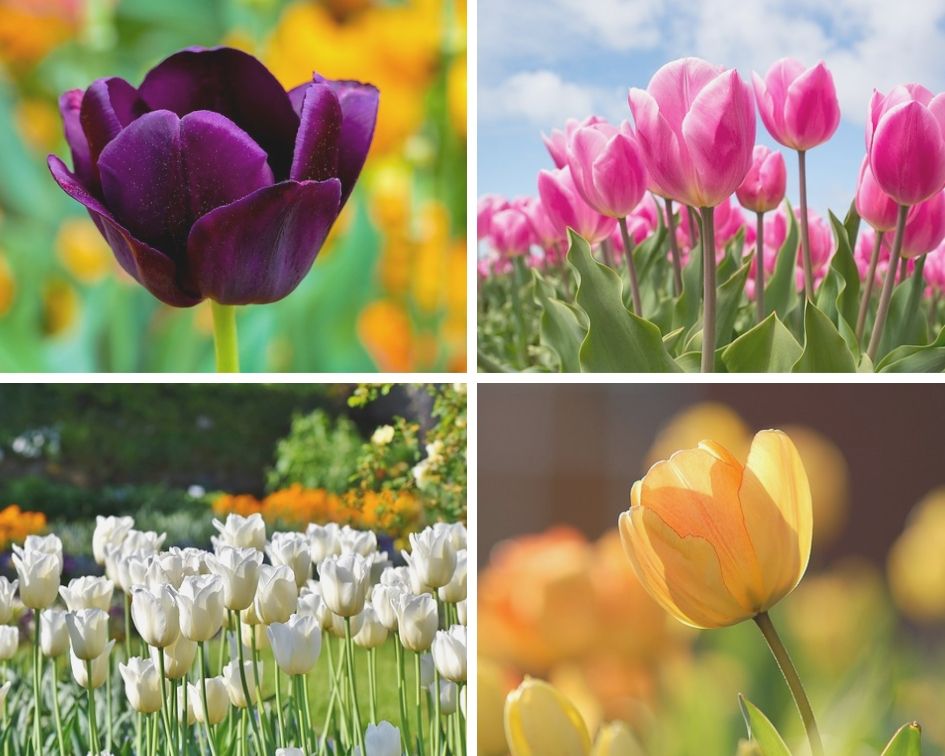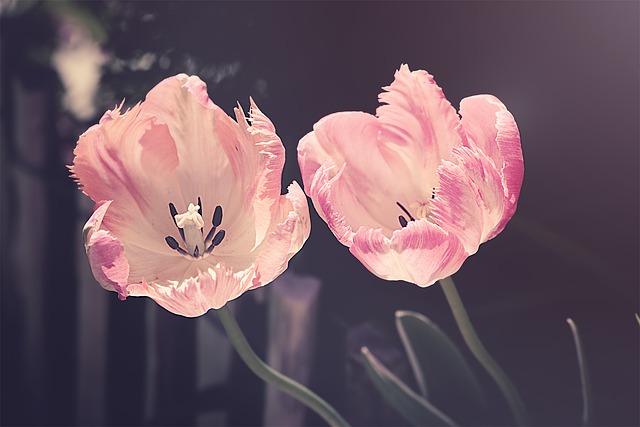Tulips are a fantastic plant to grow in your garden and while they aren’t the trickiest plant to grow, there are still plenty of mistakes to be made.
This guide is designed to take you from complete beginner to someone who can reliably grow fantastic tulips time and time again.
So let’s get stuck in!
Tulip Basics
And while they’re often thought of as a European flower (perhaps partly because of the Dutch Tulip Bubble), tulips actually originated in central Asia.
The plants that grew here originally only grew red and yellow flowers, but nowadays, thanks to hybridisation, you can find tulips in plenty of different hues.
It’s thought that we get the name tulip from the Persian word for turban, which makes sense if you consider the shape of the flower.
There aren’t too many people who don’t know what a tulip looks like; with their cup-shaped flowers consisting of three petals and three sepals, they tend to stand out in most gardens.
It’s this arrangement of petals and sepals that make them so popular for cut flowers around the world.
Another factor that makes them popular and versatile is that they can be found in lots of different sizes. Some species only grow to about 20cm in height, while others grow to around 70cm tall.
The genus, known as Tulipa, consists of about 75 species, so you can be sure there’s plenty of variety to suit you and your garden.
That said, if you’re going to be growing a lot of tulips (or handling them like we do), then you should take some precautions since there are some allergens in the stems and the leaves.
Types of Tulips
Tulips can be found in all sorts of different colours. Below you’ll see images of tulips in purple, yellow, white and pink.

Images by Katzenfee5 Free-Photos Capri23auto Rudy and Peter Skitterians
What are Parrot Tulips?

Image by Pezibear
Do Blue Tulips Exist?
Unfortunately, blue tulips do not exist. Blue tulips certainly don’t exist in nature and the closest you’ll come are a couple of hybrids such as tulip blue aimable. While they’re often sold as “blue tulips”, you can look for yourself and make your own mind up about whether or not they really count as blue tulips.
How to Grow Tulips
If you’ve read this far then you’re probably someone who wants to know how to grow the best tulips possible.
Fortunately, that’s easier than you might think since tulips aren’t the hardest plant to grow. If you can follow the guidelines below then you’ll be well on your way to growing high-quality tulips consistently.
The first thing to do is to get your hands on some high-quality tulip bulbs. It’s hard to grow nice tulips with poor bulbs.
Since bulbs carry the embryo of the plant inside them, a poor quality bulb will grow up to be a poor quality plant.
When selecting your bulbs, bigger is generally better. Also, make sure that it’s nice and firm; soft or flabby bulbs aren’t as healthy as their firmer counterparts.
Once you’ve got your hands on some nice bulbs it’s time to plant them.
How to Plant Tulips
While planting your tulips isn’t rocket science, there are a few easy mistakes you can make that will hinder the chances of your tulips growing strong.
So here’s the down-low on how to successfully plant tulips.
When should you plant your tulips? Planting them at the wrong time will mean that they won’t grow for a long time, so for best results, plant them in the Autumn so that they can flower in the Spring.
Start by digging a hole that’s about 20cm deep and then plant the bulb in the hole, ensuring that you’re planting it the right way up (the pointy end should be sticking up).
Your tulip will still grow if you plant it upside down, but you’re putting it under more stress than it needs.
Tulips also like their space; so don’t plant them too close together. If you’re planting several tulips (and why not!), make sure you leave about 10-20cm between each bulb.
Once you’re done planting, give them a quick soak with the watering can so that they can get off to a good start.
How Much Sun do Tulips Need?
Tulips are plants that like quite a lot of sun and do best in full sun. In areas with high temperatures, you can get away with putting them in a slightly shady area, but otherwise, it’s best to make sure they get all the sun they can.
What’s the Best Soil for Growing Tulips?
Tulips don’t like a lot of moisture (it can lead to bulb rot amongst other things), so they tend to do best in well-drained soil. Mediums like dry sandy soil tend to work well.
How to Water Tulips
As mentioned above, tulips don’t do the best with lots of water, so you can generally get away with watering them once a week without any trouble.
If you live in an area with plenty of rain, you probably won’t need to water the tulips at all. Overwatering can be just as harmful as underwatering, so take care.
Do Tulips need Fertiliser?
If you’re treating your tulips as perennials, then you will need to supply them with fertiliser, but if you’re treating them as annuals, then there’s no need for fertiliser as the bulb contains all the nutrients they need (for that year at least).
Should you Deadhead Tulips?
Deadheading tulips is helpful and should be done once the flowers die. However, be careful to not remove the leaves as this is how tulips gather their energy. If you find that the leaves have died off then you can safely remove them since they’re no longer contributing anything to the plant.
Pests & Diseases
Tulips are vulnerable to various pests and diseases. Here’s a short list of pests and diseases that can commonly be found on tulips:
- Grey mould
- Slugs & Snails
- Aphids
- Nematodes
- Bulb Rot
The best thing you can do to prevent your plant from acquiring any of the above is to keep it healthy. Just like with people, the healthier and stronger a plant is, the less susceptible it is to disease.
If you’ve done all you can to prevent disease and pests, but still find that your tulips aren’t well, then you need to treat them as soon as possible. What course of treatment to take depends entirely on the problem you’re trying to get rid of and is beyond the scope of this guide.
Related Questions
Q: How long do tulips last?
A: It depends on the weather. In cooler weather, the flowers might last for a week or two, but when the temperature rises, you can expect that the flowers will only survive for a few days.
Q: Are tulips perennials?
A: Traditionally, yes, tulips are perennials, but with hybridisation, many tulips are treated as annuals and discarded after their first blooming season.
Q: Are tulips poisonous?
A: While tulips may not kill you, it’s not advisable that you eat them as they can make you sick.
Q: What do tulips symbolise?
A: Tulips traditionally symbolise love, but the meaning can differ a little depending on the colour of the flower.
Conclusion
That’s all you need to know when it comes to growing tulips.
Is there something you’d like to know?
Is there something you think we missed?
If so, let us know in the comments below!


